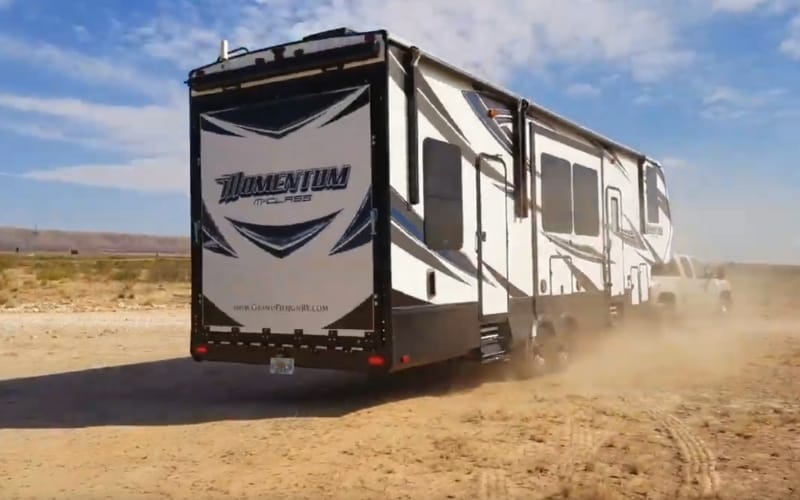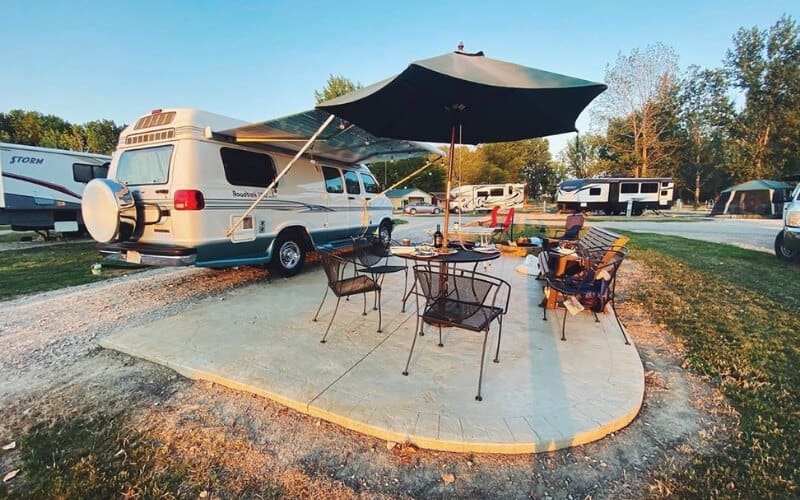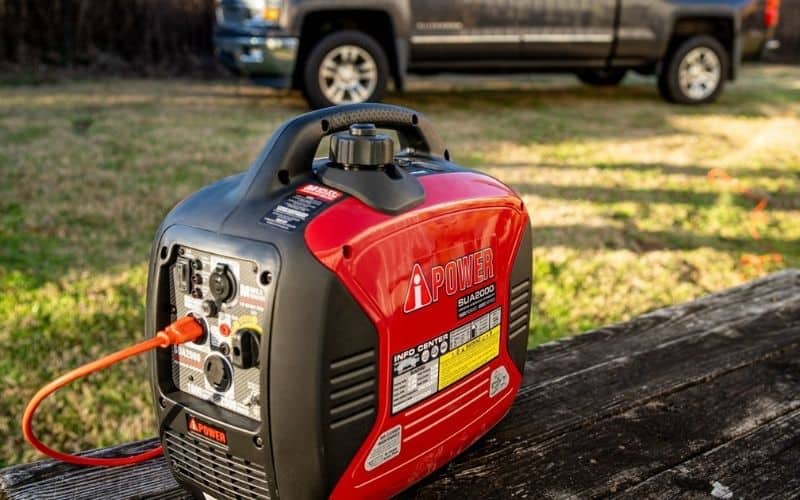Driving an RV in high winds is what we call this white-knuckle driving. Holding your steering wheel at a 45-degree angle to keep your RV straight is unnerving and exhausting.
To be honest, getting to your destination “on time” isn’t as important as making sure you get there without an accident. Of course, there are times when you absolutely need to pull over and wait things out.
But there are other times when you can adjust your driving style to keep plodding along. Slowing down, taking more frequent breaks, and being aware of windbreaks are just a few things you will need to do when driving an RV in high winds.
How do you know when winds are too heavy to continue driving your RV? And how can you monitor weather forecasts to prepare for windy days in your RV?
Tuning in to local weather reports is the best way to avoid driving an RV in high winds.
When winds come up while you are already driving, you will need to know how to handle your RV safely. If you have never driven an RV in high winds, it is hard to imagine what it feels like.
So let’s begin with a quick RV driving story of a time where we probably should have pulled over and waited for the storm to pass!
Driving an RV in High Winds and Bad Weather in New Mexico

Grandpa wanted to get across the country for my cousin’s wedding. Flying wasn’t an option, so we rented a Cruise America RV.
His two must-see destinations were Hot Springs, Arkansas and the Grand Canyon.
With a limited timeline, we did a lot of long driving pushes. With reservations booked at the Grand Canyon, we had to push all the way through northern New Mexico in one shot, and that’s when we hit the storm.
As the sun set in the west, we could see the storm front ahead.
The logical thing would’ve been to pull over and sleep. But we were not logical and we “had a place to be.”
Grandpa climbed into the back bed to attempt to sleep as I continued at the wheel. A couple of hours after dark, the winds hit us.
Moving hard from left to right, I steered into it and turned the wheel to the left just to keep the RV straight.
The first crack of thunder boomed overhead and raindrops began to hit our windshield gently.
Under an hour later, I was gripping the steering wheel as hard as possible and squinted to pick out the white line on the right side of the road.
I could barely make out the white line on the side of the road.
With less than 30 feet of visibility, we were crawling at barely 20 miles per hour. The only time visibility increased was when streaks of lightning lit up the sky.
Grandpa’s efforts to sleep were thwarted by the deafening booms of thunder right above our RV.
He soon joined me in the cockpit to watch the storm instead of attempting to sleep through it.
In the wee hours of the morning, I was finally holding the steering wheel straight again.
The next time I pulled over and shut down the engine, my hands were shaking and my nerves were shot.
As the adrenaline that was keeping me going began to decrease, I was exhausted.
I turned the keys over to my cousin and crawled into the cab-over bunk to sleep for the next five hours.
What Do Experts Consider ‘High Winds’?

Remember that you are essentially driving a large box or rectangle down the road.
While headwinds will slow you down and reduce your fuel economy, strong crosswinds threaten to blow you right off the road.
According to the National Weather Service, a high wind warning is issued when wind speeds are expected to be sustained above 40 miles per hour (64.4 km/h) or gusts exceeding 58 miles per hour (93.3 km/h) are expected within the next 36 hours.
Driving during a high wind warning is not advisable unless absolutely essential.
It is also increasingly risky for high-profile vehicles, which would include all RVs, travel trailers, fifth wheels, and other styles of campers.
When are High Winds Most Dangerous For RV Driving?
You will feel the impacts of wind on your RV once wind speeds exceed 10 to 20 miles per hour (16 to 32 km/h). When these speeds exceed 40 miles per hour, you should strongly consider getting off the road.
In our story, we were traveling on an interstate with no oncoming traffic because the eastbound and westbound lanes were separated.
There were very few other vehicles making the same questionable decision we were.
From my experience, the most dangerous RV driving conditions are when winds exceed 40 miles per hour (48 to 80 km/h) and you are driving on a two-lane road. Things become even more dangerous with many passing semi-trucks and no median separating you from oncoming traffic.
When you pass a truck in high winds, it feels like your RV is getting pulled towards the truck.
This is especially dangerous when you are experiencing winds coming from left to right because you will already be steering the wheel towards oncoming traffic.
Can an RV Flip When Driving in High Winds?

We don’t necessarily want to scare you, but the quick answer to this question is yes.
I’ve personally seen semi-trucks, RVs, travel trailers, and even boat trailers flipped completely over after a storm with exceptionally high winds.
Wind speeds exceeding 50-60 miles per hour (80.5 to 96.5 km/h) have the power to flip an RV. Larger RVs have more surface area for winds to impact, which puts them at increased risk of flipping in high winds.
Most RVs are designed to handle winds up to 80 (128.7 km/h) miles per hour when they are parked. But they are far less stable when you encounter high winds while driving.
Tips for Driving an RV in High Winds
If you are going to continue driving in heavy winds, you need to take action to mitigate the risk of driving in less-than-favorable conditions.
Here are a few useful tips for safer RV driving when you encounter howling winds.
Tip 1: Just Pull Over If You Are Uncomfortable

The best course of action if you encounter high winds when driving an RV is to pull over.
Some storms may last several minutes while others could continue for hours, but your safety is always more important than getting to your destination on time.
If you encounter exceptionally high winds about 50 or 60 miles per hour, you may also consider where you park when you pull over.
If you can find a building to park behind, it can help to serve as a windbreak to protect your RV from the direct effects of high winds.
Tip 2: Plan and Know Your Route in Advance
Whether you rely on a mounted GPS unit, your smartphone, or a road atlas for navigation, you need to plan and be familiar with your route in advance when driving in high winds.
There is no room for taking a hand off the wheel to quickly plug an address into your GPS unit in these kinds of conditions.
Take the time to pull over, research where you are going, and map out your route so that you don’t have to do it while you are driving.
Of course, if you have a co-pilot, he or she can do this research while you concentrate on driving.
Tip 3: Keep Two Hands on the Wheel

Even once you get comfortable with how sustained winds are impacting your RV, the possibility of wind gusts at higher speeds is always possible.
The best way to maintain control over your RV in high winds is to keep two hands on the wheel at 10 o’clock and two o’clock, respectively.
This doesn’t mean you need to grip your steering wheel like you would grip the handles on a downhill mountain bike on an especially rough course.
But maintaining contact with both of your hands will give you the most control when winds are pushing your RV all over the road.
Tip 4: Slow Down
While driving somewhere between 55 and 60 miles per hour is recommended to get the best gas mileage in your RV, most of us like to drive faster than that if we can do so safely.
As conditions deteriorate, however, slowing down will make it easier for you to stay in control of your vehicle.
If you usually drive between 65 and 70 miles per hour, slow down to between 55 and 60 when high winds are present.
As winds increase, you may need to slow down even further to maintain control of your vehicle.
Tip 5: Steer Into the Wind

You will most likely find yourself doing this naturally. If your RV is being pushed towards the right shoulder of the road, you will need to steer towards the center of the road in order to keep your RV running straight.
Don’t be surprised if you look down at your steering wheel to find that it is positioned significantly to the right or left while your RV actually feels like it is going rather straight in your lane.
Tip 6: Consider Turning on Hazard Lights
There’s no shame in slowing down to keep control of your vehicle. That being said, it can also be useful to turn on your hazard lights if you are going more than 10-15 miles per hour under the posted speed limit.
Every state has different hazard light laws, but windy conditions would certainly categorize as ‘bad weather’.
And most states accept the use of hazard lights when conditions don’t allow you to safely follow posted speed limits and other traffic warning signs.
Tip 7: Be Aware of Windbreaks

Like we mentioned above, each passing semi-truck can turn into a momentary windbreak when you are driving in heavy winds.
There are also other things that can have similar effects, such as overpasses, bridges, or even stretches of thick trees along the roadside.
These windbreaks can sometimes temporarily reduce the wind that is hitting the side of your RV. If you are steering into the wind.
Tip 8: Watch Other Traffic Carefully
Even if you do everything in your power to drive more safely in high winds, you need to keep your eye out for other vehicles.
This is always the case whenever you get into your RV, but it is even more important when driving in high winds.
Keep in mind that your ability to execute quick driving maneuvers in an RV is extremely limited.
If another driver makes a mistake and gets into your path, usually the best you can do is to press hard on the brakes and keep your RV running as straight as possible.
Trying to make a quick maneuver in an RV is often more dangerous than simply slowing down and running into something.
RV drivers that attempt quick evasive maneuvers are more likely to flip their rig than actually avoid the obstacle.
Tip 9: Take More Breaks

Driving an RV in heavy winds has a negative effect on your nervous system.
Your senses will be taxed to the extreme just to keep your rig on the road, so it is a good idea to take more frequent breaks when driving in these kinds of conditions.
As a rule, try to stop at least once an hour when driving in high winds.
Make these stops last from 10 to 15 minutes to give your body and senses a chance to relax. It can be nice to take a little walk to stretch your legs during these breaks.
But you may also choose to lay down and close your eyes briefly if the outside conditions make you feel more stressed and uncomfortable when walking around.
Tip 10: Switch Drivers Often If Possible
If you have another capable driver with you that feels comfortable driving in those conditions, it is also a good idea to switch drivers every time you take one of these breaks.
Sharing the driving responsibility is always a good idea on any road trip, but it is even more important if you are driving in a high wind warning.
Best Tools for Monitoring Wind Forecasts

Knowing where to find up-to-date information on expected wind speeds is as vital to safe RV travel as knowing how to drive an RV in high winds.
So here are a few tools that can help you gain valuable information about wind forecasts as you’re traveling:
1. The National Weather Service
The National Weather Service is the best place to go for wind warnings and alerts while you are on the road.
It works across the entire U.S., but may not be as reliable if your road trips take you into Canada or Mexico.
2. WindAlert.com
The Live Wind feature on WindAlert.com provides real-time visuals on wind speed and gusts in your area.
It pulls data from as many nearby weather stations as possible to provide a more accurate and comprehensive wind prediction.
3. Ventusky.com
Ventusky is a website that provides a smorgasbord of weather information. From average wind speed and wind gusts to expected precipitation, humidity levels, and air quality, this site is super useful.
It also contains data that allows you to monitor internationally and you can download an app version to your phone for roughly $2.99 per year.
4. he Windfinder App
The Windfinder app is available for both iPhone and Android users. It provides real-time information on average wind speeds, expected wind gusts, air temperature, and so much more.
Conclusion
We know that unexpected weather can frustratingly derail even the best-laid RV trip plans.
But it is important to keep what is really important in perspective when you are evaluating whether to continue driving an RV in high winds.
To be clear, your safety, your family’s safety, the safety of other people on the road, and the safety of your RV itself are all more important than sticking to your RV trip timeline.
We hope that these tips will help you evaluate when you should get off the road in high winds.
And if you do decide to continue driving in windy conditions, you can use these tips to navigate more safely on windy roadways!



![Travel Small, Live Big: 6 Class C Motorhomes Under 25 Feet for Your [currentyear] Adventures 12 Best Class C Motorhomes Under 25 Feet](https://www.rvingknowhow.com/wp-content/uploads/2021/10/Best-Class-C-Motorhomes-Under-25-Feet-150x150.jpg)


